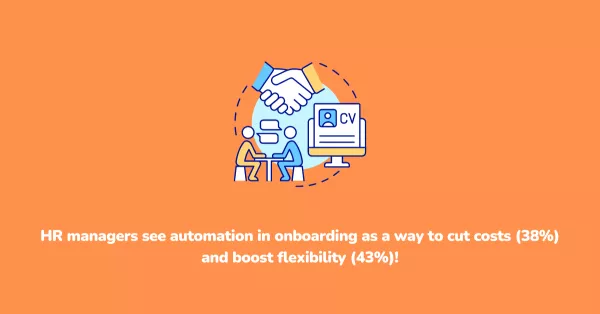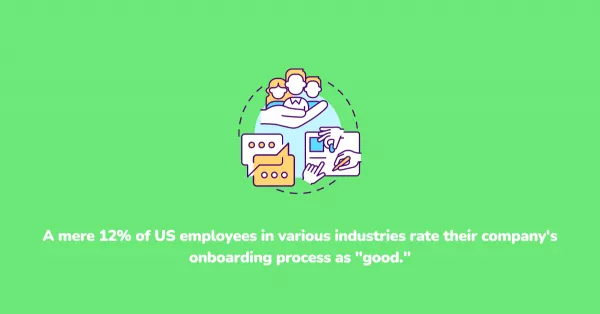First impressions matter. Especially when it comes to welcoming new hires into your organization. A strong and efficiently managed onboarding process is critical for setting employees up for success, boosting their long-term engagement, and reducing turnover.
But what if there was a way to make your process even more effective? Enter the game-changing world of data analytics. By leveraging statistical insights collected throughout the journey, you can gain valuable insights into how well your program works and personalize the experience for each new hire.
Imagine this, instead of a generic, one-size-fits-all approach, you can tailor content and resources based on an individual's specific role, skills, and learning preferences. Statistics can help you identify areas where new hires might need additional support, allowing you to intervene early and bridge any knowledge gaps. It can also empower you to measure the effectiveness of your onboarding process, track employee engagement, and pinpoint areas for improvement.
Are you using data in your process? If not, you're missing out on a powerful opportunity to optimize your program and maximize the potential of your new hires.
The Traditional Onboarding Approach
The traditional onboarding process, while well-intentioned, often falls short of maximizing employee potential. Imagine a new hire's first day, a whirlwind of paperwork, company handbook reviews, and hurried introductions to colleagues. This approach, while efficient in terms of completing essential tasks, can be overwhelming and fails to truly engage new hires.
Here's a closer look at the typical steps involved in a traditional program:
- Pre-boarding - This might involve new hires completing necessary paperwork online or in person. While crucial for administrative purposes, it doesn't actively engage the new employee with the company culture or mission.
- First Day - The focus is often on logistics – setting up workstations, IT access, and benefits enrollment. While important, these tasks are administrative and don't provide much opportunity for learning about the role or team dynamics.
- Company Orientation - A general overview of the company's history, mission, and values might be presented. However, this information is often delivered in a generic way, failing to connect it to the new hire's specific role and responsibilities.
- Product or Service Training - This is a core element, but traditional methods often involve lengthy manuals or standardized training modules that might not cater to individual learning styles or address specific role-related needs.
The limitations of this traditional approach are numerous:
- One-Size-Fits-All - The generic nature of traditional onboarding doesn't consider the diverse needs and backgrounds of new hires. A recent graduate might require a different approach compared to a seasoned professional with relevant experience.
- Information Overload - New hires are bombarded with information in a short timeframe. This can lead to information overload and difficulty retaining key details about the role and company.
- Limited Engagement - The focus on administrative tasks and generic information sessions can leave new hires feeling disengaged and unsure of their role within the team and company.
- Lack of Feedback - Traditional onboarding often lacks avenues for leveraging feedback from new hires. This valuable data can be used to identify areas of confusion or difficulty and make adjustments to the program.
In essence, the traditional approach prioritizes completing tasks over fostering a smooth transition and a sense of belonging for new hires. While it may appear efficient on the surface, it can ultimately hinder employee engagement and hinder their ability to reach full productivity quickly.
By contrast, a data-driven approach leverages information collected throughout the journey to personalize the experience, address individual needs, and ultimately, create a more successful program for both the company and the new hire.
The Power of Data-Driven Onboarding
The traditional approach might get the job done in terms of administrative tasks, but it often leaves valuable information untapped: the rich statistics that can be gleaned from the experience itself. This is where data-driven automated onboarding steps in, offering a transformative approach that personalizes the journey for each new hire and optimizes program effectiveness.
Onboarding Data and Analytics Defined
Let's first define the key terms. Data encompasses any information collected during the onboarding process about a new hire and their experience. These statistics can come from various sources, including:
- Application Materials - Resumes, cover letters, and pre-employment assessments can reveal skills, experience, and areas of potential interest.
- Onboarding Surveys - Targeted surveys at key points during the process can gather feedback on the experience itself, highlighting areas of confusion or difficulty.
- Learning Management System (LMS) Data - If your company uses an LMS for training, statistics on course completion rates, progress, and assessment scores can provide insights into learning styles and knowledge gaps.
- Performance Reviews - Early performance reviews can offer valuable feedback on how well the program prepared the new hire for their role.
Data analytics then comes into play. This refers to the process of collecting, analyzing, and interpreting onboarding statistics to gain meaningful insights. By leveraging data analytics, you can transform your understanding of the onboarding experience and use those insights to personalize the program and improve its effectiveness.
Benefits of Data-Driven Onboarding

Here's a deeper dive into how data can unlock the full potential of your onboarding program:
Personalized Onboarding Experiences
Onboarding stats allow you to tailor the journey to each new hire's unique needs and background. For instance, an analysis of a new hire's resume and LMS stats can reveal areas of prior experience and knowledge gaps. This information can then be used to curate a personalized plan that focuses on areas requiring additional support and streamlines content for areas where the new hire already possesses strong skills.
Identifying Knowledge Gaps
Analyzing stats from surveys, LMS platforms, and early performance reviews can help pinpoint specific areas where new hires might need additional support. For example, if a high percentage of new hires score poorly on an assessment related to a specific software program, it might indicate a need for more in-depth training or revised training materials.
Measuring Onboarding Effectiveness
Data analytics empowers you to track key metrics and measure the overall effectiveness of your program. Metrics such as employee engagement, time-to-productivity, and retention rates can be analyzed to identify areas for improvement. For instance, a high turnover rate shortly after onboarding might indicate a need to revisit the program's content or support structure.
Predicting Success Potential
While not a definitive measure, data analytics can be used to identify high-potential employees. By analyzing stats on prior experience, performance during training, and early performance reviews, you can create targeted development plans for high-potential individuals, accelerating their growth within the company.
Getting Started with Data-Driven Onboarding

The potential of data-driven processes is clear, but how do you actually get started? Here's a practical guide that outlines the steps you can take to incorporate stats into your onboarding process:
Define Your Goals and Objectives
Before diving headfirst into stats collection, take a step back and define your goals and objectives for data-driven onboarding. What specific aspects of the experience do you want to improve? Here are some questions to consider:
- Do you want to increase employee engagement during onboarding?
- Are you aiming to reduce the time it takes for new hires to reach full productivity?
- Do you want to identify areas where your program might not be meeting the needs of new hires?
By clearly defining your goals, you can tailor your stats collection and analysis efforts to gather the most relevant information.
Identify Data Sources
Once you have a clear understanding of your goals, identify the sources that will provide the most valuable insights. Here are some common sources of data:
- Application Materials - Resumes, cover letters, and pre-employment assessments can reveal skills, experience, and areas of potential interest for new hires.
- Onboarding Surveys - Targeted surveys at key points during the process can gather feedback on the program itself, highlighting areas of confusion or difficulty. Consider pre-boarding surveys to gauge expectations, mid-program surveys to assess progress, and post-program surveys to measure overall satisfaction.
- Learning Management System (LMS) Data - If your company uses an LMS for training, data on course completion rates, progress, and assessment scores can provide insights into learning styles and areas where new hires might need additional support.
- Performance Reviews - Early performance reviews can offer valuable feedback on how well the program prepared the new hire for their role. Identify specific areas where content or support could be adjusted to improve performance.
- Exit Interviews - While not directly related to this, exit interview numbers from departing employees can sometimes reveal areas where the program fell short, allowing you to identify and address potential issues proactively.
Choose the Right Data Collection Tools
The tools you choose to collect the numbers will depend on your specific needs and resources. Here are some options to consider:
- Online Surveys - Free and paid online survey tools can be used to create and distribute surveys. These tools offer features for collection, analysis, and reporting.
- Learning Management Systems (LMS) - If you already use an LMS for training, leverage its built-in reporting capabilities to track numbers on course completion rates, progress, and assessment scores.
- HR Information Systems (HRIS) - Many HRIS platforms offer collection and reporting functionalities that can be used to track these data. Consider integrating your LMS with your HRIS for a more centralized repository.
- People Analytics Platforms - For companies with advanced data analytics needs, dedicated people analytics platforms can be used to collect, analyze, and visualize onboarding numbers alongside other HR data points.
Data Security and Privacy
Data security and employee privacy are paramount concerns when collecting and analyzing onboarding data. Ensure you have clear policies and procedures in place to protect employee data. Here are some key considerations:
- Transparency - Be transparent with new hires about what data is being collected during the program and how it will be used. Obtain their consent for collection and clearly explain their rights to access and modify their data.
- Data Security - Implement appropriate security measures to protect employee data from unauthorized access, use, or disclosure.
- Data Minimization - Only collect what is relevant and necessary for your goals. Avoid collecting excessive personal data that is not directly related to the onboarding process.
Develop a Data Analysis Plan
Once you've collected your onboarding data, it's time to analyze it to extract meaningful insights. Here's how to approach this step:
- Identify Key Metrics - Align your data analysis plan with the goals you defined earlier. Choose specific metrics to track, such as employee engagement scores, time-to-productivity, or course completion rates.
- Data Visualization - Use visualization tools like charts and graphs to present these stats in a clear and easy-to-understand format. This will help you identify trends and patterns within your onboarding data.
- Actionable Insights - Don't get bogged down in the numbers themselves. Aim to translate your findings into actionable insights that can be used to improve your program. For example, if the finidings reveal low engagement scores for a specific training module, you might decide to redesign the module for improved interactivity.
Continuous Improvement
Being data-driven is a continuous process. Regularly analyze your data, identify areas for improvement, and refine your onboarding program accordingly. Here are some additional tips for continuous improvement:
- Feedback Loop - Establish a feedback loop to gather ongoing input from new hires on their onboarding experience. This can be done through informal discussions, focus groups, or short feedback surveys.
- A/B Testing - Consider A/B testing different approaches to see what works best. For example, you might test the effectiveness of a new training module by delivering it to a smaller group of new hires before rolling it out to the entire organization.
- Benchmarking - Benchmark your onboarding program against industry standards or best practices to identify areas for improvement. Resources like industry reports and HR publications can provide valuable benchmarks.
Challenges and Considerations
While data-driven processes offer significant advantages, there are also challenges to consider:
- Data Overload - Collecting too much can be overwhelming and hinder the analysis process. Focus on gathering the most relevant points that align with your defined goals.
- Data Quality - The quality of your insights will depend on the quality of the numbers you collect. Ensure that what is entered is entered accurately and consistently to avoid skewed results.
- Technical Expertise - Data analysis can require some level of technical expertise. Consider upskilling your HR team or partnering with data analysts to leverage the full potential of your data.
- Employee Privacy Concerns - Address employee concerns about data privacy proactively. Be transparent about collection practices and ensure robust security measures are in place.
Conclusion
Data-driven programs represent a powerful strategy for maximizing the effectiveness of your program. By leveraging data to personalize the experience, address individual needs, and measure program effectiveness, you can create a smooth transition for new hires, accelerate their time-to-productivity, and ultimately, foster a more engaged and successful workforce.
Take action today to implement data-driven onboarding in your organization. Identify your goals, choose the right collection tools, and develop a data analysis plan. By continuously analyzing and refining your program, you can ensure your experience remains relevant and effective and sets your new hires up for long-term success.
Why OrangeHRM?
Now that you're equipped with the knowledge to implement data-driven onboarding, you might be wondering how to put it all into practice. OrangeHRM can be your one-stop solution for streamlining your onboarding process and leveraging data for maximum impact. OrangeHRM goes beyond simply managing tasks. By centralizing data within its platform, it empowers you to analyze the information gathered throughout the experience. This allows you to identify areas for improvement, personalize the journey for each new hire, and ultimately, optimize your program for long-term success. Find out how OrangeHRM can help you optimize your onboarding process book your FREE demo today!
